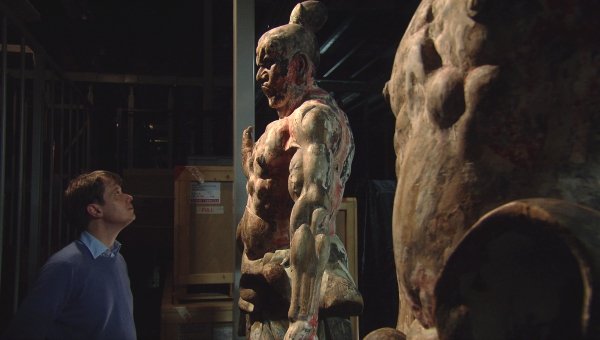
Holland’s most famous museum, The Rijksmuseum, was closed for almost a decade between 2004 and 2013 in order to undergo a nearly £300 million pound renovation. It was originally estimated to take half that time. THE NEW RIJKSMUSEUM follows the project as it faces hurdle after endless hurdle.
When we are first introduced to the museum the renovation is already underway. Stripped of her art and décor, the museum looks less a palace of high culture and more, as the caretaker puts it, ‘a war zone’. The building is a long way from the providing a deserving home to the Netherlands’ most prized cultural possessions. As we tour the building’s brick skeleton one by one the project’s helmsmen are introduced. Some of these, such as the ambitious Taco Dibbits and the faintly obsessive curator Menno Fitski, will provide points of continuity as the years roll by.
An auction bid for one artwork turns out to be a surprisingly tense and heartbreaking moment
A struggle for many documentaries is to be interesting to those who would not normally be intrigued by its subject matter. THE NEW RIJKSMUSEUM avoids this thanks to the passion of the museum’s curators, whose emotional investment in their work is infectious. While each curator specialises in their own crucial aspect of the project, something that unifies them all is the identical twinkle in each one’s eye. Even as frustrations mount their love for the museum and the art within rarely wavers. While sometimes inaccessible to those of us lacking in a love of the high arts, the art itself is still evidently worth cherishing. An auction bid for a piece that would be crucial to the museum’s 20th Century section turns out to be a surprisingly tense and heartbreaking moment. The same goes for the acquisition of two dynamic Japanese statues. After being acquired the pair are locked in storage thanks to the setbacks, and it is undoubtedly sad to see them anywhere else but on display.
The film aims to show us the full scope of the project, not shying away from even comparatively unexciting quandaries. The array of challenges presented — bureaucratic, financial, political — are all given time. While it is a shame so little attention can be spared on the museum’s content itself, spending time to focus on tedious exchanges is what elevates this documentary from more than just an advert. The onslaught of endless frustrations makes you itch for the project’s completion just as much as the curators. One of the Rijksmuseum’s biggest controversies was its proposed grandiose entrance. The plans for a design said to rival that of the Louvre were scrapped after uproar from Amsterdam’s Cyclist Union. The battle for the cyclists to use the public paths under the museum is the root cause of much of the conflicts. At first this seems nothing more than pettiness, but it drags on, an ever-present nuisance for both the museum workers and the viewer. As the Museum director Wim Pijbes points out late in the film, he spends more time concerning himself with cyclists than with Rembrandt.
The project is shown stopping and starting, sometimes with explanation and sometimes not
Although it is already known that the project took almost 10 years, the film doesn’t always do an adequate job of conveying this passage of time. The project is shown stopping and starting, sometimes with explanation and sometimes not. There is a recurring motif of newspaper headlines on a pinboard which intermittently offers up some context. However jumps in time from the museum’s flooded dirt floor to the final stages of decoration can be somewhat unsatisfactory.
THE NEW RIJKSMUSEUM takes no interest in glamorising the museum like a tourist information film. Instead it turns its head to examine planning permission forms and paint swatches. With so many facets of this massive renovation under the film’s lens, it’s hard not to be fascinated as you follow the many steps and stumbles of the Rijksmuseum’s journey.
httpvh://www.youtube.com/watch?v=HwLnKLkIQ_A

